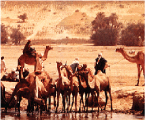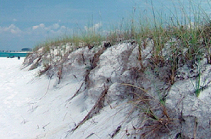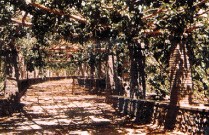|
DroughtsThe problem often occurs when nomads living in dry areas move to less arid areas. The extra people and animals disrupt the local ecosystem and increase the rate of erosion of the land. Nomads are trying to escape the desert, but instead they end up bringing the desert with them. It might seem as if droughts cause desertification; however, this is really not the case. Droughts are common in arid and semiarid lands, but well-managed lands can recover from drought when the rains return. The real damage is caused by misusing the land during droughts. The misuse of land can have deadly consequences. Poor management of the land during a drought that began in 1968 in western Africa caused so much damage that more than 100,000 people and 12 million cattle died in a five-year period. Satellites have improved our understanding of desertification. Multiple images of the same area, taken several years apart, can show changes in the land. Studies using these images can illustrate the impact of people and animals on the earth. There has been a lot of discussion about desertification in the media, but there are still many things that scientists do not understand about the process. Despite reports, desertification may often be reversible. There is concern about the continue spread of desertification, but conservationists are working on ways to protect areas and reclaim land.
For instance, to prevent sand from blowing away, sand dunes can be covered with large boulders, or sometimes petroleum, which prevents the sand from moving. Sand fences are used throughout the Middle East and the United States to catch the sand and keep it from spreading. Another way to help with the problem is to plant vegetation in areas where there is some water available for the plants. The growing plants can be protected with straw mats until their roots develop. Oases and farmlands that are in windy regions are sometimes protected by planting tree fences or grass belts. The grass belt collects much of the sand, and the strips of trees act as windbreaks. Small plots of trees may also be scattered inside oases to stabilize the area. In a large-scale stabilization effort, a "Green Wall" is being planted in northeastern China to protect deserts that are believed to have been created by human activity. It will eventually stretch more than 3,500 miles in length—much longer than the famous Great Wall.
Some other ways that people are working to stop desertification is to use water more efficiently. New ways are being sought to use surface water, such as collecting rain or capturing seasonal runoff mountains as is done in the western United States. New ways are also being used to find and tap groundwater and to develop better ways of irrigating. Scientists are also focusing on proper crop rotation to protect the fragile soil. Hopefully desertification can be stopped and reversed by using resources wisely.1 Footnotes 
|
About Us | Terms of Use | Contact Us | Partner with Us | Press Release | Sitemap | Disclaimer | Privacy Policy
©1999-2011 OpenLearningWorld . com - All Rights Reserved




